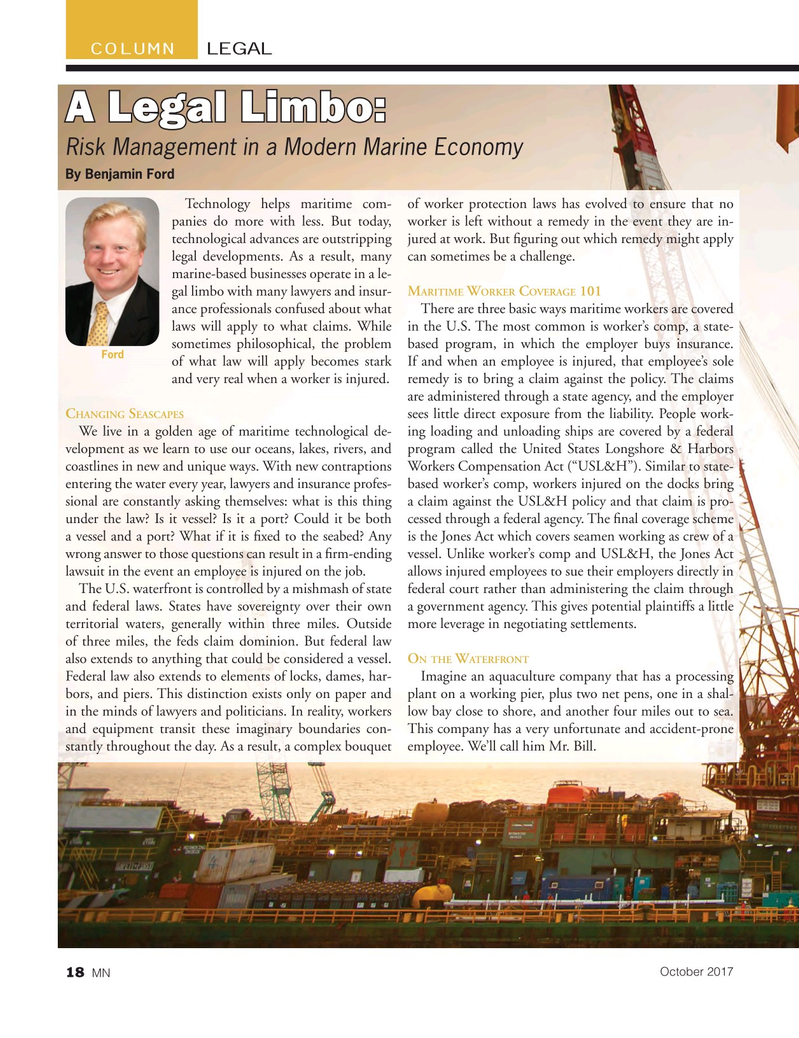
Page 18: of Marine News Magazine (October 2017)
Salvage & Spill Response
Read this page in Pdf, Flash or Html5 edition of October 2017 Marine News Magazine
COLUMN LEGAL
A Legal Limbo: A Legal Limbo:
Risk Management in a Modern Marine Economy
By Benjamin Ford
Technology helps maritime com- of worker protection laws has evolved to ensure that no panies do more with less. But today, worker is left without a remedy in the event they are in- technological advances are outstripping jured at work. But ? guring out which remedy might apply legal developments. As a result, many can sometimes be a challenge. marine-based businesses operate in a le-
ARITIME ORKER OVERAGE gal limbo with many lawyers and insur- M W C 101 ance professionals confused about what There are three basic ways maritime workers are covered laws will apply to what claims. While in the U.S. The most common is worker’s comp, a state- sometimes philosophical, the problem based program, in which the employer buys insurance.
Ford of what law will apply becomes stark If and when an employee is injured, that employee’s sole and very real when a worker is injured. remedy is to bring a claim against the policy. The claims are administered through a state agency, and the employer
HANGING EASCAPES
C S sees little direct exposure from the liability. People work-
We live in a golden age of maritime technological de- ing loading and unloading ships are covered by a federal velopment as we learn to use our oceans, lakes, rivers, and program called the United States Longshore & Harbors coastlines in new and unique ways. With new contraptions Workers Compensation Act (“USL&H”). Similar to state- entering the water every year, lawyers and insurance profes- based worker’s comp, workers injured on the docks bring sional are constantly asking themselves: what is this thing a claim against the USL&H policy and that claim is pro- under the law? Is it vessel? Is it a port? Could it be both cessed through a federal agency. The ? nal coverage scheme a vessel and a port? What if it is ? xed to the seabed? Any is the Jones Act which covers seamen working as crew of a wrong answer to those questions can result in a ? rm-ending vessel. Unlike worker’s comp and USL&H, the Jones Act lawsuit in the event an employee is injured on the job. allows injured employees to sue their employers directly in
The U.S. waterfront is controlled by a mishmash of state federal court rather than administering the claim through and federal laws. States have sovereignty over their own a government agency. This gives potential plaintiffs a little territorial waters, generally within three miles. Outside more leverage in negotiating settlements.
of three miles, the feds claim dominion. But federal law also extends to anything that could be considered a vessel. O W
N THE ATERFRONT
Federal law also extends to elements of locks, dames, har- Imagine an aquaculture company that has a processing bors, and piers. This distinction exists only on paper and plant on a working pier, plus two net pens, one in a shal- in the minds of lawyers and politicians. In reality, workers low bay close to shore, and another four miles out to sea. and equipment transit these imaginary boundaries con- This company has a very unfortunate and accident-prone stantly throughout the day. As a result, a complex bouquet employee. We’ll call him Mr. Bill.
October 2017 18
MN

 17
17

 19
19
